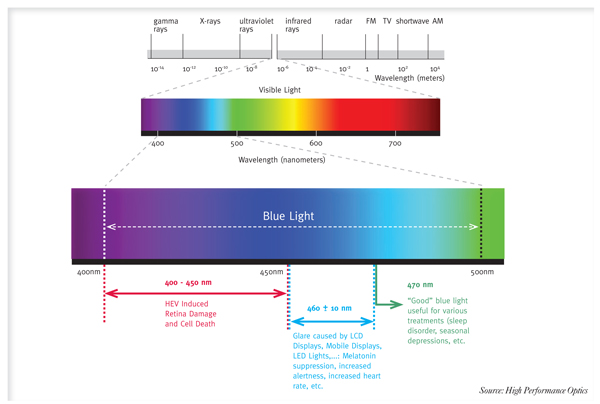
As digital device usage soars, the resulting digital eyestrain and exposure to damaging blue light has created a new product category for regional optical retailing groups—blue light lenses. As of January 2014, 90 percent of American adults had a cell phone, 58 percent had a smartphone, 32 percent owned an e-reader, and 42 percent owned a tablet computer, according to the Pew Internet Projects mobile technology research.
As the number of hours spent using these devices increases so does exposure to the blue light they emit that can cause damage to the eye. According to The Vision Council’s October 2014 VisionWatch Digital Eye Strain Report, one third of the 110,000 adult U.S. residents surveyed use digital devices two to five hours per day, followed closely by those who use devices for six to nine hours. “In total, 63.5 percent of the adult population uses digital devices between two and nine hours daily,” according to The Vision Council Report. Educating consumers about the blue light these devices emit, how it can damage the eye, and the blue-light-blocking lenses that are available, can lead to increased sales of these products.
The optical industry has done a great job of educating consumers about the dangers of UV and the need to protect eyes from these dangers. Now is the time to educate ourselves, our staff, and our patients and customers throughout all locations about the
dangers of blue light and the lenses that are available to prevent damage to our patients’ retinas.
Blue light is part of the visible light spectrum from 400nm to 500nm. At the low end of the blue light spectrum the rays have the highest energy or potential damage to daily vision and long term vision loss. This high energy visible (HEV) light, which is centered around 430nm (±20 nm), impacts daily vision and visual performance. In simple terms, blue light affects everyone since it is defocused in front of the retina. This occurrence known as chromatic aberration causes blurry vision and disabling glare in all patients exposed to blue light.
The second major result from exposure to HEV blue light is Age Related Macular Degeneration (AMD). AMD is the leading cause of blindness for those over the age of 50. It affects one in five families and is more common than Alzheimer's, Parkinson's, breast cancer, and prostate cancer combined.
The third and last major impact of blue light is on our general health and wellness. Blue light exposure at night suppresses melatonin, which assists with sleep. Blue light exposure at night from electronic screens and compact fluorescent and LED lighting can suppress melatonin. In the short term, this can lead to sleep loss. Over time, this exposure to blue light can result in more serious conditions such as cancer and diabetes.
There are three major ophthalmic blue light solutions: blue light protective coatings for indoor use, protective lenses for indoor use, and protective lenses for outdoor use. Here’s a link to
10 Products That Block Blue.
As with all new product offerings, staff and doctor education across all of your locations are central to adoption and success. It is also important that all staff and doctors in all of your locations wear blue light protective lenses. There is no better recommendation than personal experience coupled with feedback from customers who report improved vision.
“Among the 73 percent of the general adult population who are unaware of HEV/blue light and it’s damage to your eyes, most (more than 85 percent) admitted that they would proactively take some course of action to prevent HEV light from damaging their eyes if an eyecare professional alerted them to the dangers of HEV/blue light,” according to The Vision Council VisionWatch Digital Eye Strain Report.
Demonstration tools can also help show how blue light protective products filter damaging blue light. Take a blue laser penlight and place a blue light protective lens in front of the laser light. The blue light passing through the lens is significantly reduced. This demonstration is very dramatic and customers have the opportunity to ‘see’ the benefits.
Evan Kestenbaum, MBA, is chief information officer of
GPN, Exclusive Provider of The EDGE, and Valerie Manso is a GPN success coach. Contact them directly at
clientservices.gpn@gmail.com.